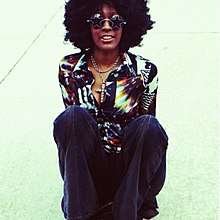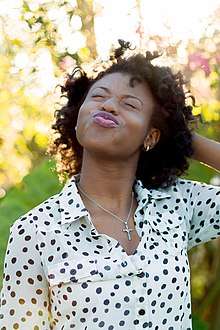Curly Girl Method

The Curly Girl Method is an approach to hair care designed for naturally curly hair that has not been relaxed. It is similar to the "no poo" method in that it discourages the use of shampoo. Among other things, it calls for the use of conditioner in place of shampoo (also called "conditioner washing" or "co-washing"), no silicones (used in many commercial conditioners and styling products), no blowdrying, and no combs, brushes, or terrycloth towels. It also includes tips for using hair gel and other styling products. The aim in general is to treat curly hair gently, minimizing damage to the hair cuticle; to keep it moisturized, since curly hair is more prone to dryness than straight hair; and, perhaps most significantly, to accentuate rather than interfere with the hair's natural curl.[1][2][3][4][5][6][7][8][9]
History

While variations of the method had been in use before then, in 2001 it was introduced to a wider audience by hairstylist Lorraine Massey in her bestselling book, Curly Girl: The Handbook. When the book was first published, straight hair was the prevailing style for women in the U.S., the U.K., and elsewhere, and many women felt pressured to straighten their hair with flat irons or relaxers. Massey writes in her introduction about growing up in England, where she was ridiculed for having curly hair. When she moved to New York City, she had an eye-opening experience: "Jewish, Italian, Latino, and African-American people living around me had curly hair that looked like mine! I no longer looked or felt like an outsider."[1] Since the early 2010s, curly hairstyles have become more popular.[10]
Variations

People with various hair textures have adapted the method to their needs. Popular variations include the use of sulfate-free shampoos, which are more widely available now than they were in 2001, and occasional blow-drying with the use of heat protectants.
The method is also used by males; the name "curly girl" reflects the relative importance of hair care to women and girls due to societal expectations.[11] The method can also be used on kinky, coily, and wavy hair, which are often treated as curly hair types or "curl patterns" on hair care websites and in hair typing systems.
As co-washing has become more popular, consumer demand has spawned a new hair product, the "cleansing co-wash", which proponents claim removes buildup from the hair and scalp without the harsh "stripping" or drying effects of traditional shampoo.
Massey's book also includes techniques for cutting curly hair, such as cutting the hair when dry rather than wet.[12] Related hair cutting techniques include the Deva cut,[13] Ouidad cut,[14] and RI CI cut.[15]
Other authors have written curly hair care guides which focus on specific hair types. Curly Like Me: How to Grow Your Hair Healthy, Long, and Strong by Teri LaFlesh provides natural hair care tips especially for tight curls.[16] Better than Good Hair: The Curly Girl Guide to Healthy, Gorgeous Natural Hair by Nikki Walton focuses on Afro-textured hair.[17] Writers at the Naturally Curly website provide hair care advice based on curl pattern, porosity, and other factors.
The curly girl method also requires one to know one's hair porosity. There are low, medium and high hair porosity. Low hair porosity is when the hair cuticles are tightly shut. Low porosity hair has difficulty obtaining moisture but once moisture is absorbed it will remain moisturized. This porosity type is common with hair that has suffered little to no damage (either from heat styling tools or from chemicals) and thus it is the preferred porosity level. Medium porosity hair is when the hair cuticles are loose, allowing moisture to be easily absorbed and retained. High porosity is when there are gaps in the hair cuticles which allows the hair to easily absorb the moisture but also easily lose the moisture just as easily as it was absorbed. These gaps are caused by long term damage to the hair from things like over-manipulation, heat damage and chemical damage from hair dyes and relaxers. [18]
See also
References
- 1 2 Massey, Lorraine; Bender, Michele; Chiel, Deborah (2011). Curly Girl: The Handbook. Workman Publishing. pp. 1–5. ISBN 9780761156789.
- ↑ McDermott, Aisling. "Aisling on Beauty". The Irish Times.
- ↑ Lewis, Jessica (May 20, 2014). "Super Natural: MahoganyCurls Reveals What She Learned About The Curly Girl Method". Essence.
- ↑ Saint Louis, Catherine (September 29, 2010). "Sulfate-Free Products Have Some in a Lather". The New York Times.
- ↑ Meltzer, Marisa (August 27, 2014). "Curls Get Their Groove Back". The New York Times.
- ↑ "Technique sparks debate about curly-girl locks". The Houston Chronicle. August 25, 2002.
- ↑ Salkin, Allen (February 15, 2004). "Under a Banner of 'Curly Power,' A Do Can Coil With Pride". The New York Times.
- ↑ Garone, Elizabeth (January 15, 2013). "Testing Hair Salons That Cater to the Curls". Wall Street Journal.
- ↑ Fischler, Marcelle (January 18, 2007). "Taming Frizz and Setting Curls Free". The New York Times.
- ↑ Day, Elizabeth (July 28, 2013). "Hair today: straight or curly?". The Guardian.
- ↑ Massey, p. 135
- ↑ Massey, p. 97
- ↑ "Devachan Salon". www.devacurl.com. Retrieved 2018-07-04.
- ↑ "Our Hair Salons for All Curl Types". www.ouidad.com. Retrieved 2018-07-04.
- ↑ "No, Deva Cut is Not the Only Haircut for Curly Hair". Naturally Curly.
- ↑ LaFlesh, Teri (2010). Curly Like Me: How to Grow Your Hair Healthy, Long, and Strong. Wiley. ISBN 9780470536421.
- ↑ Walton, Nikki (2013). Better Than Good Hair: The Curly Girl Guide to Healthy, Gorgeous Natural Hair. Harper Collins. ISBN 9780062123770.
- ↑ "Hair Porosity Types for naturally curly hair - NaturallyCurly.com". www.NaturallyCurly.com. Retrieved October 29, 2017.
External links